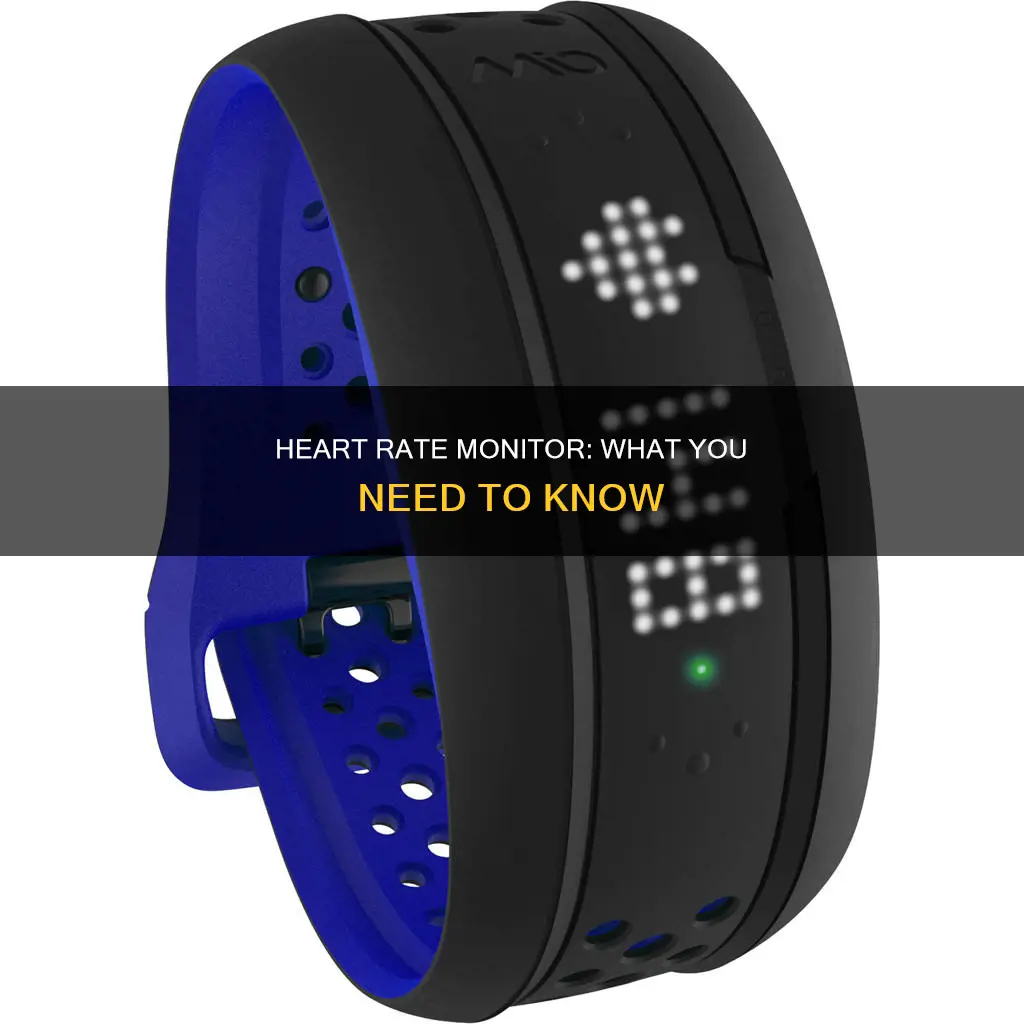
If you're experiencing symptoms like chest pain, shortness of breath, dizziness, or an irregular heartbeat, your doctor may recommend that you wear a heart monitor. A heart monitor is a small, wearable device that records your heart's activity over 24 to 48 hours or more, providing valuable data that can help your doctor diagnose any heart-related issues. There are two main types of heart monitors: Holter monitors, which provide continuous monitoring, and event monitors, which only record activity when triggered by the patient. During the monitoring period, you'll be asked to keep a diary of your activities and any symptoms you experience, which will be compared with the monitor's data to help identify any problems.
| Characteristics | Values |
|---|---|
| Purpose | To detect and track your heart or pulse rate continuously |
| Wearability | Most are wearable devices |
| Accuracy | Many are highly accurate, but not as accurate as approved medical devices |
| Use cases | Tracking heart rate during exercise, monitoring stress and activity levels, tracking sleep quality, monitoring vital signs |
| Types | Chest-band devices, Wrist- or forearm-worn wearables, Smart rings, Pulse oximeters, Smartphones |
| Detection methods | Electrical (electrocardiography), Optical (photoplethysmography) |
| Risks | Minimal, but an allergy to the materials is possible |
What You'll Learn
- Wearable heart rate monitors are generally accurate, but not as precise as approved medical devices
- Chest straps are the most accurate way to track your heart rate, but wrist-worn devices are more convenient
- Heart rate monitors can be used to track health, exercise, sleep quality, and stress levels
- Optical sensors in wrist-worn devices detect pulse rate, while chest straps detect heart rate
- Heart rate monitors can be used to track your cardiovascular fitness and endurance

Wearable heart rate monitors are generally accurate, but not as precise as approved medical devices
Wearable heart rate monitors are popular features in smartwatches and fitness trackers. They are designed for everyday use and can be valuable tools for monitoring your health. They can track your heart rate continuously, and many are highly accurate.
However, it's important to note that these devices are not as precise as approved medical devices. While they can provide valuable insights, they should not be used as a substitute for medical care or medical devices, which meet strict quality and accuracy standards.
The accuracy of wearable heart rate monitors can vary depending on the type of device and the user's activity. For example, wrist-worn devices tend to be very accurate when the user is resting or walking, but activities that involve arm movements can cause inaccurate readings. Additionally, optical heart rate monitors, which use light to measure blood flow, may be less accurate during vigorous activity or when used underwater.
To ensure the most accurate results, it is important to follow the instructions provided with the device and ensure a proper fit. While wearable heart rate monitors offer convenience and insights into your health, they should be used as a complementary tool alongside regular medical care.
Attaching Your ASUS Monitor to a Wall Mount: Easy Steps
You may want to see also

Chest straps are the most accurate way to track your heart rate, but wrist-worn devices are more convenient
Heart rate monitors are devices that can track your heart rate continuously and are available as wearable devices. While they are valuable tools in monitoring your health, they are not as accurate as approved medical devices.
Chest straps and wrist-worn devices are the two most common types of heart rate monitors. Chest straps are considered the most accurate way to track your heart rate. They use electrocardiography to record the electrical activity of your heart. The electrical sensors in chest straps can detect electrical currents produced by your heart, similar to an ECG at the doctor's office. They are especially useful during vigorous activity.
Wrist-worn devices, on the other hand, are more convenient and comfortable to wear. They use optical heart rate sensors that employ light to track your pulse rate in the arteries as blood pumps through them. While they are less accurate than chest straps, they are still useful for reading your heart rate at rest or during light activities like walking.
Wrist-worn devices are also more susceptible to user error. They need to be worn tightly enough to prevent movement during exercise, which can be uncomfortable. Chest straps, on the other hand, are more difficult to adjust and can be uncomfortable due to the snug fit.
So, if you are looking for the most accurate heart rate readings, especially during intense exercise, a chest strap monitor is the best option. However, if you prioritize convenience and comfort, a wrist-worn device might be more suitable, keeping in mind the potential for user error and reduced accuracy during high-intensity activities.
Destroying an LCD Monitor: Step-by-Step Guide
You may want to see also

Heart rate monitors can be used to track health, exercise, sleep quality, and stress levels
Heart rate monitors are devices that can be used to detect and track your heart rate or pulse rate. They are usually wearable devices, such as smartwatches, fitness trackers, or chest straps, and they can be incredibly useful for tracking health, exercise, sleep quality, and stress levels.
Tracking Health
Heart rate monitors can be used to monitor your health and track your heart rate during exercise. This is important because your heart rate is a key indicator of how intense your workout is. By tracking your heart rate, you can ensure that you are exercising within a safe and effective range. Additionally, monitoring your heart rate can help you adjust your energy output to match the optimal level for burning fat.
Tracking Exercise
Heart rate monitors can also be used to track your exercise performance and progress. They can help you identify your training target and calculate your heart rate limits, such as your resting heart rate, maximum heart rate, and heart rate reserve. This information can guide you in designing workouts that challenge you without overexerting yourself.
Tracking Sleep Quality
Wrist-based heart rate monitors, in particular, can be worn continuously, even while sleeping. By tracking your heart rate throughout the night, these devices can provide insights into your sleep quality and help you understand your body's recovery process.
Tracking Stress Levels
Heart rate variability, which can be measured using a heart rate monitor, is a useful indicator of stress levels. By tracking your heart rate variability, you can gain valuable information about your body's response to stress and make informed decisions to manage it effectively.
While heart rate monitors are valuable tools for tracking health and fitness, it is important to remember that they are not a substitute for medical devices or professional healthcare. If you have specific health concerns or conditions, it is always best to consult a healthcare professional for personalized advice and monitoring.
Ultimate Monitor Size for the Nintendo Unisystem Arcade
You may want to see also

Optical sensors in wrist-worn devices detect pulse rate, while chest straps detect heart rate
Heart rate monitors are devices that can detect and track your heart rate or pulse rate. They are available as wearable devices, such as smartwatches and fitness trackers, and can also be connected to smartphones and computers. There are two main types of heart rate monitors: optical sensors and chest straps.
Optical sensors in wrist-worn devices detect pulse rate by using light-emitting diodes (LEDs) and sensors that rest against the skin. These sensors use LED lights to detect the tiny expansions of the blood vessels underneath the skin's surface. The wrist is an ideal location for these sensors because there are two major arteries in the wrist and forearm that provide plenty of blood flow to the skin. This allows the sensors to accurately detect the pulse rate. Wrist-worn devices are very convenient and can be worn continuously, making them ideal for tracking heart rate during exercise, monitoring stress and activity levels, and tracking sleep quality. They tend to be very accurate when the user is resting or walking and can also be accurate during running or cycling. However, using the arms for exercise activities can cause inaccurate readings.
On the other hand, chest straps detect heart rate electronically and send the data to a wristwatch-style receiver. They use electrical detection to track the heart rate by detecting the electrical activity of the heart. Chest straps are typically more accurate than wrist-worn devices, especially when used properly. They measure the heart rate directly, which gives them higher accuracy regardless of the user's activity. However, chest straps may be less comfortable and require additional preparation, such as wetting the band or using a conductive gel, to improve electrical conduction.
Both optical sensors in wrist-worn devices and chest straps have their advantages and limitations. Optical sensors are convenient, comfortable, and provide continuous heart rate tracking, while chest straps offer more accurate measurements, especially during intense activities. The choice between the two depends on the user's preferences, the type of activity being performed, and the level of accuracy required.
Understanding UserMode on Your ASUS Monitor
You may want to see also

Heart rate monitors can be used to track your cardiovascular fitness and endurance
Heart rate monitors are an excellent tool to track your cardiovascular fitness and endurance. They can help you determine your resting heart rate, which is a key indicator of your overall health and fitness. By tracking your heart rate over time, you can monitor changes and adjust your workouts accordingly to lead a healthier life.
There are two main types of heart rate monitors: chest straps and optical monitors. Chest straps use electrodes to detect electrical activity and track your heart rate. They are usually connected to a wristwatch-style receiver that displays your heart rate in real time. Optical monitors, on the other hand, use light-based technology (photoplethysmography or PPG) to measure blood flow and heart rate. These are commonly found in wrist-based wearables, like smartwatches and fitness trackers.
When choosing a heart rate monitor, consider your specific needs and preferences. Chest straps tend to be more accurate but may be uncomfortable for some people. Wrist-based monitors are more convenient and can be worn continuously, aiding in recovery and sleep data tracking. Additionally, consider the features you require, such as target heart rate zones, calorie counters, GPS capabilities, and compatibility with other devices.
By using a heart rate monitor, you can gain valuable insights into your cardiovascular fitness. You can track your heart rate during workouts, adjust your intensity, and optimise your exercise routine for better endurance and overall health. Heart rate monitors are a great tool to help you understand your body's limits and capabilities, allowing you to create a personalised exercise plan that suits your fitness goals.
Taking Screenshots on Your ASUS Monitor: A Step-by-Step Guide
You may want to see also
Frequently asked questions
While heart rate monitors are valuable tools for monitoring your health, they are not as accurate as approved medical devices. Chest-strap monitors are the most accurate, especially when used properly. Wrist-worn devices tend to be very accurate when you are resting or walking, but using your arms for exercise activities can cause inaccurate readings.
Heart rate monitors use two different approaches: electrical (electrocardiography) and optical (photoplethysmography). Electrical detection measures the small electrical current generated by your heart with each heartbeat. Optical detection uses infrared light to see the expansion of your arteries as your heart pumps blood through them.
Heart rate monitors can help you track your health, create and manage an exercise plan, and monitor your vital signs at home. They can also be used to track sleep quality and monitor stress and activity levels during the day.
Examples of heart rate monitors include chest-band devices, wrist- or forearm-worn wearables, smart rings, pulse oximeters, and smartphone apps.







